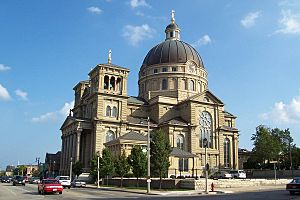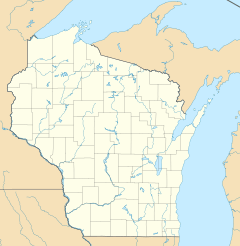Basilica of St. Josaphat facts for kids
Quick facts for kids Basilica of Saint Josaphat |
|
|---|---|

The Basilica of St. Josaphat
|
|
| Religion | |
| Affiliation | Roman Catholic |
| Province | Archdiocese of Milwaukee |
| Ecclesiastical or organizational status | Minor basilica |
| Status | Active |
| Location | |
| Location | Milwaukee, Wisconsin, United States |
| Architecture | |
| Architect(s) | Erhard Brielmaier (architect) Gonippo Raggi (painter) |
| Architectural type | Church |
| Architectural style | Polish cathedral style |
| Completed | 1901 |
| Official name: Basilica of St. Josaphat | |
| Designated | March 7, 1973 |
| Reference no. | 73000089 |
| Governing body | Private |
The Basilica of St. Josaphat, located in the Lincoln Village neighborhood of Milwaukee, Wisconsin, United States, in the Archdiocese of Milwaukee, is one of 82 American minor basilicas. In its grandeur and opulence it is an excellent example of the so-called Polish cathedral style of church architecture found in the Great Lakes region of North America. Modeled after St. Peter's Basilica in Rome, it features one of the largest copper domes in the world. It is listed on the National Register of Historic Places and is a designated Milwaukee Landmark.
Dedication
The Basilica of St. Josaphat was dedicated to Josaphat Kuncevyc, a Ruthenian martyr and saint of the Roman Catholic Church, as well as of the Ukrainian Greek Catholic Church.
History
Poles began trickling into Milwaukee in the 1840s, but the flow increased after the Civil War until their numbers were next only to the German-Americans. In 1866 Saint Stanislaus parish was founded - the first urban Polish parish in the U.S. St. Stanislaus branched off Josaphat's congregation in 1888. Josaphat's first church building burned in 1889. It was rebuilt, but in 1896, when the parish church proved to be too small, Pastor Wilhelm Grutza commissioned Erhard Brielmaier, a prominent church architect of the late 19th and early 20th centuries, to design a new church. Like a number of other Polish churches, it was designed in the so-called Polish cathedral style. Like St. Mary of the Angels in Chicago and Immaculate Heart of Mary in Pittsburgh, the architectural plans were modeled on St. Peter's Basilica in Rome.
As the design neared completion, Father Grutza learned that the U.S. Custom House, Court House, and Post Office in Chicago was being razed. He purchased the 200,000 tons of salvage material for $20,000 and had it delivered to Milwaukee on 500 railroad flatcars, where parishioners were waiting to begin construction.
The basilica was formally dedicated in 1901 by Archbishop Francis Xavier Katzer with 4,000 people in attendance. Once completed, it met the needs of Milwaukee's growing Polish Catholic population by seating 2,400 members and was the city's largest church. Artist Tadeusz Żukotyński created the first painting in the church, The Martyrdom of St. Josaphat, in 1904.
Decoration on the interior was completed in 1928 by artists Conrad Schmitt and Gonippo Raggi. Detailed oil paintings depicting biblical scenes adorned the walls and inner dome, while ornamental plasterwork finished in gold leaf set the columns, and ornate stained glass covered the windows.
In 1929, Pope Pius XI designated St. Josaphat Church as the third minor basilica in the United States, marking it as a place of pilgrimage, special devotion, and historical significance.
An electrical fire in 1940 caused extensive smoke damage to the interior, and a lightning storm in 1947 dislodged several large blocks of stone from the base of the dome. The need for repairs could no longer be ignored. Structural maintenance and renovation of the murals began in earnest from 1948 through 1951.
Strong winds in 1986 tore a sheet of copper from the dome and severe water damage occurred. A subsequent need for financial assistance was the impetus for partnerships with the Order of Friars Minor Conventual and several prominent businessmen from the Polish community. This led to the establishment of the St. Josaphat Basilica Foundation in 1991 and allowed large scale restoration work, again by Conrad Schmitt Studios, to begin.
Construction
The original plans drawn by architect Erhard Brielmaier called for brick construction. When it was decided that salvage material from the demolished U.S. Custom House, Court House, and Post Office in Chicago was to be used, Erhard had to redesign to incorporate stone as the primary building material.
Each block was measured and numbered for a best fit in the new design and hardly any stone was re-cut or went to waste. A large field nearby was used for material storage and sorting as it came off the railroad flatcars.
Six large granite columns from the Chicago building, along with their carved stone capitals, were added to the plans. The original ornamental bronze railings, lighting fixtures, and doors were also used.
Before construction could begin, a broad hill standing 30 feet (9.1 m) tall needed to be leveled. This task was completed using man and horse power, hauling earth to the western shore of the Kinnickinnic River.
The cornerstone was placed on July 4, 1897. Unskilled parishioners did most of the work under Erhard's guidance. Hired help from among the poor also contributed, when church funds allowed.
Since domestic Portland cement was of unknown quality at the time, German Dyckerhoff cement was imported for the foundation, while old railroad ties served as reinforcement. Heavy steel rails were also used in the concrete footings for the eight piers that supported the 214 ft (65 m) dome.
On July 21, 1901, a high mass presided over by Archbishop Francis Xavier Katzer marked the formal completion and dedication of the basilica.
Interior decoration
The first mural for the church, The Martyrdom of St. Josaphat, was painted in 1904 by Tadeusz Żukotyński; it is directly behind and above the altar. Most of the other murals were painted by Gonippo Raggi. The basilica's stained glass windows were imported from Austria in 1902. Conrad Schmitt Studios later restored the interior of the basilica to its 1926 decorative grandeur.
See also
 In Spanish: Basílica de San Josafat (Milwaukee) para niños
In Spanish: Basílica de San Josafat (Milwaukee) para niños
- List of churches in the Roman Catholic Archdiocese of Milwaukee
- Lincoln Village, Milwaukee
- Polish Cathedral style
- Wacław Kruszka
- Tadeusz Żukotyński
- List of tallest buildings in Milwaukee


